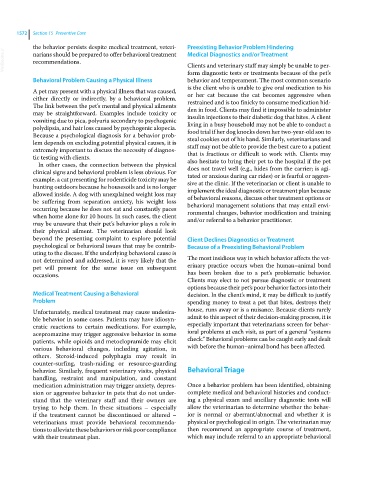Page 1634 - Clinical Small Animal Internal Medicine
P. 1634
1572 Section 15 Preventive Care
the behavior persists despite medical treatment, veteri- Preexisting Behavior Problem Hindering
VetBooks.ir narians should be prepared to offer behavioral treatment Medical Diagnostics and/or Treatment
recommendations.
Clients and veterinary staff may simply be unable to per-
form diagnostic tests or treatments because of the pet’s
Behavioral Problem Causing a Physical Illness behavior and temperament. The most common scenario
is the client who is unable to give oral medication to his
A pet may present with a physical illness that was caused, or her cat because the cat becomes aggressive when
either directly or indirectly, by a behavioral problem. restrained and is too finicky to consume medication hid-
The link between the pet’s mental and physical ailments den in food. Clients may find it impossible to administer
may be straightforward. Examples include toxicity or insulin injections to their diabetic dog that bites. A client
vomiting due to pica, polyuria secondary to psychogenic living in a busy household may not be able to conduct a
polydipsia, and hair loss caused by psychogenic alopecia. food trial if her dog knocks down her two‐year‐old son to
Because a psychological diagnosis for a behavior prob- steal cookies out of his hand. Similarly, veterinarians and
lem depends on excluding potential physical causes, it is staff may not be able to provide the best care to a patient
extremely important to discuss the necessity of diagnos- that is fractious or difficult to work with. Clients may
tic testing with clients. also hesitate to bring their pet to the hospital if the pet
In other cases, the connection between the physical
clinical signs and behavioral problem is less obvious. For does not travel well (e.g., hides from the carrier; is agi-
tated or anxious during car rides) or is fearful or aggres-
example, a cat presenting for rodenticide toxicity may be sive at the clinic. If the veterinarian or client is unable to
hunting outdoors because he housesoils and is no longer implement the ideal diagnostic or treatment plan because
allowed inside. A dog with unexplained weight loss may of behavioral reasons, discuss other treatment options or
be suffering from separation anxiety, his weight loss behavioral management solutions that may entail envi-
occurring because he does not eat and constantly paces ronmental changes, behavior modification and training
when home alone for 10 hours. In such cases, the client and/or referral to a behavior practitioner.
may be unaware that their pet’s behavior plays a role in
their physical ailment. The veterinarian should look
beyond the presenting complaint to explore potential Client Declines Diagnostics or Treatment
psychological or behavioral issues that may be contrib- Because of a Preexisting Behavioral Problem
uting to the disease. If the underlying behavioral cause is
not determined and addressed, it is very likely that the The most insidious way in which behavior affects the vet-
pet will present for the same issue on subsequent erinary practice occurs when the human–animal bond
occasions. has been broken due to a pet’s problematic behavior.
Clients may elect to not pursue diagnostic or treatment
options because their pet’s poor behavior factors into their
Medical Treatment Causing a Behavioral decision. In the client’s mind, it may be difficult to justify
Problem spending money to treat a pet that bites, destroys their
Unfortunately, medical treatment may cause undesira- house, runs away or is a nuisance. Because clients rarely
ble behavior in some cases. Patients may have idiosyn- admit to this aspect of their decision‐making process, it is
cratic reactions to certain medications. For example, especially important that veterinarians screen for behav-
acepromazine may trigger aggressive behavior in some ioral problems at each visit, as part of a general “systems
patients, while opioids and metoclopramide may elicit check.” Behavioral problems can be caught early and dealt
various behavioral changes, including agitation, in with before the human–animal bond has been affected.
others. Steroid‐induced polyphagia may result in
counter‐surfing, trash‐raiding or resource‐guarding
behavior. Similarly, frequent veterinary visits, physical Behavioral Triage
handling, restraint and manipulation, and constant
medication administration may trigger anxiety, depres- Once a behavior problem has been identified, obtaining
sion or aggressive behavior in pets that do not under- complete medical and behavioral histories and conduct-
stand that the veterinary staff and their owners are ing a physical exam and ancillary diagnostic tests will
trying to help them. In these situations – especially allow the veterinarian to determine whether the behav-
if the treatment cannot be discontinued or altered – ior is normal or aberrant/abnormal and whether it is
veterinarians must provide behavioral recommenda- physical or psychological in origin. The veterinarian may
tions to alleviate these behaviors or risk poor compliance then recommend an appropriate course of treatment,
with their treatment plan. which may include referral to an appropriate behavioral

